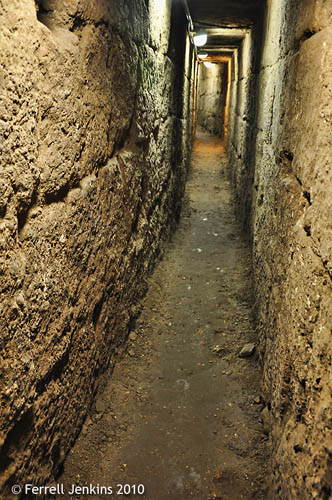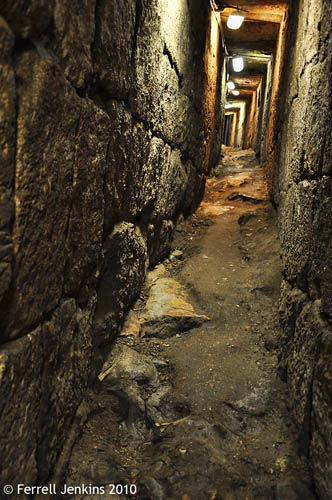The Israel Antiquities Authority announced September 10, 2007 the discovery of a channel that is thought to run from the Temple Mount to the Pool of Siloam, or further.
In excavations the Israel Antiquities Authority is conducting in the City of David in order to expose the main road of Jerusalem from the time of the Second Temple period, the city’s main drainage channel was discovered. According to the writings of Josephus Flavius, the residents of the city fled to this channel at the time of the revolt in order to hide from the Romans.
In excavations the Israel Antiquities Authority is jointly carrying out with the Elad Association in the Walls around Jerusalem National Park, approximately 70 meters of Jerusalem’s main drainage channel from the time of the Second Temple period have been exposed so far. The channel is located along the route from the Temple Mount to the Shiloah Pool. The channel, which passes beneath the main road of the city and apparently continues to Nahal Kidron on its way to the Dead Sea, drained the rainfall of ancient Jerusalem; the Jewish quarter, the western region of the City of David and the Temple Mount.
The complete report may be read here.
Old news, you say. Here is what is new. My group had the opportunity May 7, 2010, to walk through the channel. Twice before I had walked along a portion of the steps leading uphill from the Pool of Siloam, but this was my first time to walk in through the channel (sewer). It was the first time my local guide had walked through the channel.
Ronnie Reich and Eli Shukron, the excavators, are quoted as saying,
“There is evidence in the writings of Josephus Flavius, the historian who described the revolt, the conquest and the destruction of Jerusalem, that numerous people took shelter in the channel and even lived in it for a period until they succeeded to flee the city through its southern end.”
In some of the media reports this comment includes a reference to The Jewish War. I admit to not being a great Josephus scholar, but I have been unable to locate a specific reference like this in Josephus. He does speak of the citizens of Jerusalem hiding in subterranean caverns of the temple (under the platform, I assume) (5:102), and he mentions secret passages (JW 5:497). If a reader has located the reference to the channel I would be pleased to have it. This does sound like a reasonable suggestion.
This first photo was made closer to the Pool of Siloam.
The next one is closer to the northern end of the current excavation. I would say this is a about half way from the Pool to the Temple Mount. At this point the channel begins to have the smell of a sewer.
The current channel exits on the west side of the street.
This photo was made as I walked up toward the Temple Mount. You can see the southern wall of the Temple Mount. The building on the right, past the flags, is the entrance to the City of David operated by the Ir David Foundation.
The next photo shows the view to the south toward the Pool of Siloam, and eventually the point at which the Tyropean, Hinnom, and Kidron valleys come together.
Update: Be sure to read the comment by Tom Powers in which he mentions other possible references from Josephus. You may also find Tom’s articles helpful. See his israelpalestineguide.wordpress.com blog here.
How? When we were looking at the mural showing a reconstruction of the Pool of Siloam, our guide (Elie) started to go back the way we entered. An elderly gentlemen who was selling booklets said we could now go through the channel. Fortunately he was correct!





Pingback: Roman sword & menorah engraving discovered | Ferrell's Travel Blog
Pingback: Possible speaker’s podium found in City of David | Ferrell's Travel Blog
Pingback: Drainage channel provides evidence of Roman siege of Jerusalem | Ferrell's Travel Blog
Joyce, the distance from the location of the temple at the time of Jesus and the pool of Siloam would be about one half mile.
what is the exact walking distance between John 9 aand the pool of Siloam
Pingback: Roman sword & menorah engraving discovered | Ferrell's Travel Blog
Pingback: Unique golden bell found in Jerusalem drain | Ferrell's Travel Blog
Pingback: Here and there in the Holy City | Ferrell's Travel Blog
Pingback: From Damascus to Emmaus » Was The Valley of Hinnom (Gehenna) a Smoldering Rubbish Heap in The Time of Jesus?
Pingback: Featured on The Book & The Spade program « Ferrell's Travel Blog
Pingback: #1235 – The Sewers of Jerusalem « The Book & The Spade
Yes sir, a couple of dozen or so from the Pikes Peak church in Colorado Springs walked through that tunnel March 26, 2010. My friend Kevin and I led a group of 49 to Israel, and we appreciate your articles on the web. You helped us customize our itinerary and made our tour so much better!
Very interesting post and photos! One question: How did you manage to get in there!?
The passage from Josephus I like to use with people on-site, especially on the broken, stepped street with the smaller drain running beneath, is War 6:428-9: “The entire nation was now shut up by fate as in a prison, and the Roman army encompassed the city when it was crowded with inhabitants [refugees] … the Romans slew some of them, some they carried captives, and others they made search for underground, and where [when] they found where they were, they broke up the ground and slew all they met with.” The following verses (6:430-432) go on to describe the ghastly scene in “these caverns” (which I suppose could describe any underground space) at the very end.
I think Reich & Shukron may be over-reaching a bit with their comment. At least, I don’t know of a passage about people successfully escaping through these particular channels. War 5:497 says specifically that, even before construction of the circumvallation wall, the Romans were guarding all “the known passages out of the [city]”, which I presume would include built drains and sewers running under the main streets. The Jews’ few sallies through the seige lines, it says, were through “secret passages”.
Tom Powers / JERUSALEM
Pingback: Walking Through the Sewers of First Century Jerusalem « Biblical Paths